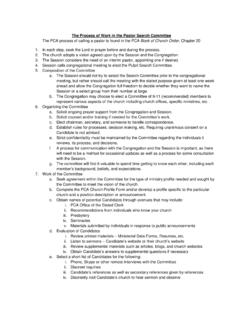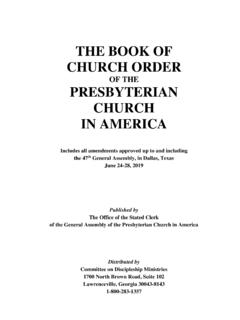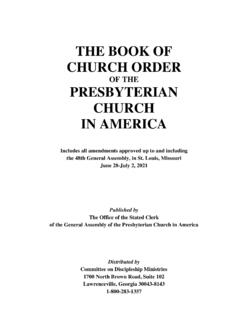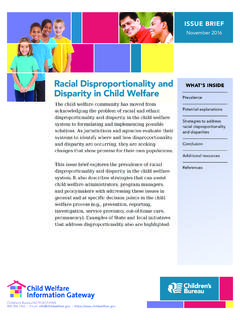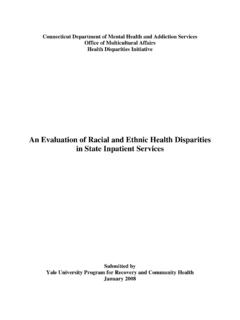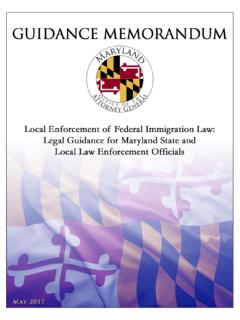Transcription of REPORT OF THE AD INTERIM COMMITTEE ON RACIAL AND …
1 Commissioner Handbook 2018 2401 REPORT OF THE AD INTERIM COMMITTEE 1 ON RACIAL AND ETHNIC RECONCILIATION 2 TO THE FORTY-SIXTH GENERAL ASSEMBLY 3 OF THE PRESBYTERIAN CHURCH IN AMERICA 4 5 6 Introduction 7 8 The 44th General Assembly, in response to a Overture 45 from Potomac Presbytery, 9 established an ad INTERIM COMMITTEE to study issues related to RACIAL Reconciliation. Our 10 COMMITTEE had a four-part mandate. First, the COMMITTEE was charged to assess the current 11 situation in the PCA concerning RACIAL and ethnic reconciliation. Next, we were to identify 12 specific problems the PCA needs to address to promote RACIAL reconciliation and ethnic 13 diversity. In addition, the COMMITTEE was to develop constructive guidelines and suggest 14 concrete steps for the use of the PCA, including all presbyteries and sessions in order to make 15 progress toward the work of RACIAL reconciliation.
2 Finally, the COMMITTEE was to REPORT to the 16 45th General Assembly (M44GA, p. 84). 17 18 Over the past two years, the COMMITTEE has made strides toward fulfilling this mandate. The 19 45th General Assembly assisted the COMMITTEE significantly by approving our plan to utilize 20 LifeWay Research Services in order to survey current attitudes on issues of race among our 21 teaching and ruling elders. Working with LifeWay has allowed us to collect significant data 22 that will allow us to assess the current situation, identify specific problems that our 23 denomination needs to address, and offer concrete steps to make progress on this issue. We 24 also recommend further assessment in order to provide longitudinal study to determine change 25 and progress over time. 26 27 As the COMMITTEE has worked, we have been conscious that we are building on previous work 28 done by preceding Assemblies. We remember that the 30th General Assembly (2002) pledged 29 itself to strive, in a manner consistent with the Gospel imperatives, for the encouragement of 30 RACIAL reconciliation, the establishment of urban congregations, and the enhancement of 31 existing ministries of mercy in our cities, among the poor, and across all social, RACIAL , and 32 economic boundaries to the glory of God (M30GA, p.)
3 262). 33 34 We have worked within the definitions and direction of the Pastoral Letter on Racism 35 approved by the 32nd (2004) General Assembly (M32GA, pp. 427-457; p. 121). And so, we 36 have presumed the definitions of race and racism contained in that document: 37 38 Race 39 The word race, as used in this pastoral letter, is not a scientific 40 classification; rather, in the language of one author, the term race is used 41 to denote a social phenomenon with a biological component (Sowell, Race 42 and Culture). That is, the term race not only pertains to the color of skin 43 44 Commissioner Handbook 2018 2402 and other biological factors, but also may include the cultural factors, 1 associations, and assumptions that we attach to certain races as well 2 (M32GA, p. 436). 3 4 Racism 5 Racism is an explicit or implicit belief or practice that qualitatively 6 distinguishes or values one race over other races.
4 Racism includes the social 7 exclusion or judgment, or the segregating, of an individual or group of 8 individuals based on RACIAL differences, which always include physical 9 appearance and its underlying genetic structure that are hereditary and 10 unalterable (M32GA, p. 435). 11 12 While we recognize the good biblical-theological work offered by the Pastoral Letter, in our 13 REPORT we return to some of that ground in order to provide the necessary biblical-theological 14 framework for reflecting upon the data received from LifeWay Research Services as well as 15 to consider our analysis and suggestions for moving forward. 16 17 Of course, we have also been mindful of the recent action of the 44th General Assembly 18 (2016), which acted to recognize, confess, condemn, and repent of corporate and historical 19 sins, including those committed during the Civil Rights era, and continuing RACIAL sins of 20 ourselves and our [and] of past failures to love brothers and sisters from minority 21 cultures in accordance with what the Gospel requires, as well as failures to lovingly confront 22 our brothers and sisters concerning RACIAL sins and personal (M44GA, p.)
5 70, p. 76). 23 That Assembly also recommitted itself to the gospel task of RACIAL reconciliation, diligently 24 seeking effective courses of action to further that goal, with humility, sincerity and zeal, for 25 the glory of God and the furtherance of the Gospel (p. 76). 26 27 These Assembly actions have served as frameworks for this COMMITTEE s study and 28 recommendations. However, we also know that from the very beginning of the PCA s 29 existence, the biblical-theological framework was present to deal with issues of RACIAL sin and 30 to seek RACIAL reconciliation and justice. Not only did the Advisory Convention of the 31 Continuing Presbyterian Church, meeting in August 1973, declare that our church would 32 welcome fellow believers in Christ regardless of race (Minutes of the Advisory Convention 33 of the Continuing Presbyterian Church, Asheville, North Carolina, August 7-9, 1973, p.
6 27). 34 In addition, at the first General Assembly, O. Palmer Robertson gave an address that provided 35 the necessary theological framework for moving forward on this issue. 36 37 Robertson declared that the continuing church movement that gave birth to the PCA was 38 committed to searching out the implications of Scripture for the totality of human life. Far 39 from a narrowing fundamentalism, the PCA s theological commitment was to determine how 40 the faith related to spiritual and social issues, which had to include RACIAL reconciliation, 41 justice, and diversity. Indeed, it is to the faith of Christianity in its fullness, as it relates to the 42 whole of creation, that the Continuing Church commits itself, he said. May the hallmark of 43 Commissioner Handbook 2018 2403 the lifestyle of its members be an awareness that Christ came preaching the Kingdom of 1 God. 1 As the Bible teaches over and over, this saving rule of God would extend to the nations, 2 to a multi- RACIAL , multi-ethnic people.
7 3 4 In other words, the COMMITTEE was not starting from scratch in offering its REPORT . Rather, we 5 are building upon biblical-theological insights and pastoral reflection that has been present in 6 the PCA since before her founding in December 1973. Our REPORT opens with a series of 7 affirmations and rejections that the COMMITTEE adopted at the beginning of its work as guiding 8 principles for our study. From there, we offer three sections of biblical-theological, confessional, 9 and pastoral-mission reflections that frame the work of RACIAL reconciliation. We move then to 10 REPORT in summary fashion the research data collected by LifeWay Research Services with 11 specific suggestions for advancing the cause of RACIAL reconciliation in church planting, mono-12 ethnic congregations, presbyteries, and academic institutions. The REPORT concludes with 13 recommendations for the 46th General Assembly to consider that will extend this COMMITTEE s 14 work in a longitudinal manner and create an on-going assessment process for our church as it 15 engages in this work.
8 Our great hope is that this REPORT will offer a pathway for our church to 16 reflect the eschatological body of Revelation 7, drawn from every nation, from all tribes and 17 peoples and languages (Rev. 7:9). 18 19 Guiding Principles: Affirmations and Denials 20 21 Affirmations 22 23 We affirm the Bible as God breathed infallible and inerrant. 24 25 We affirm the vision of the redeemed in Revelation 7:9-11, where all nations and 26 ethnicities are fulfilled in Christ. 27 28 We affirm the image of God reflected in all people. 29 30 We affirm the image of Christ reflected in His body. 31 32 We affirm that for the Christian, all human identities must be subordinate to identity 33 in Christ. 34 35 We affirm that biblical righteousness has dimensions of both piety and justice. 36 37 We affirm the Westminster Standards. 38 39 40 Denials 41 42 We reject theological liberalism defined by J.
9 Gresham Machen in Christianity and 43 Liberalism as a different gospel from the Scriptural gospel. 44 1 O. Palmer Robertson, The Continuing Church and the Faith Once Delivered, Addresses Delivered During the First General Assembly (Birmingham, AL: Continuing Presbyterian Church, 1973), 20. Commissioner Handbook 2018 2404 We reject Marxism and Socialism, and all ideologies based on either one or both. 1 2 We reject racism in all its forms; ontological, cultural, systemic, et al. 3 4 We reject as aberrant and anti-biblical any theological formulations incorporating 5 racism or RACIAL superiority ( , Kinism).2 6 7 We reject intersectionality not solely based on biblical 8 9 We reject human identities that demand precedence over identity in Christ. 10 11 We reject human identities based on unbiblical lifestyles or behaviors. 12 13 We reject the notion that God s people are designated by anything other than God s 14 sovereign election.
10 15 16 We reject as inadequate any analysis of racism that does not recognize sin and the fall 17 of mankind as its root. 18 19 Biblical and Theological Foundations 20 21 The Bible does not begin with the fall; it begins with creation. Actually, it begins with God, 22 the majestic sovereign creator of the universe. Genesis 1:1 says, In the beginning, God 23 created the heavens and the earth. The Hebrew word that is translated create is bara. 24 This particular form of the verb always refers to divine activity. It is used to show that God is 25 the one who took the initiative to create. He took the initiative to bring into existence 26 something that never existed before the heavens and the earth. He created them out of 27 nothing by the word of his power. He did so in a space of six days. Repeatedly, as God creates, 28 the first chapter of the Bible tells us that God saw that it was good.


